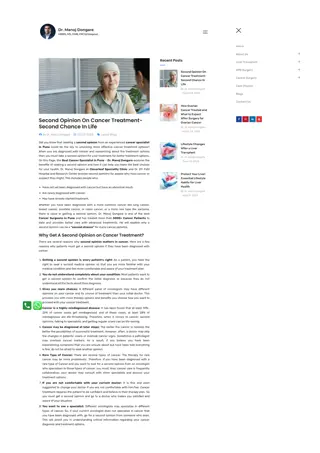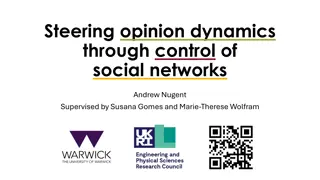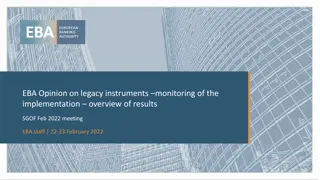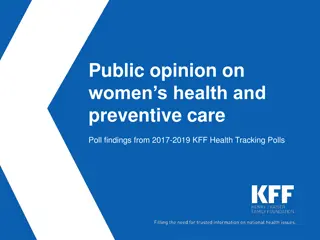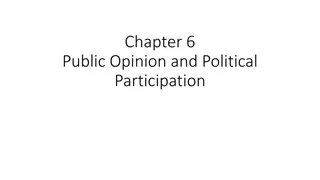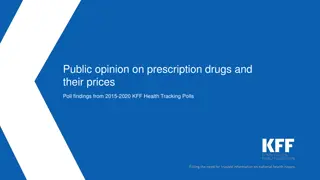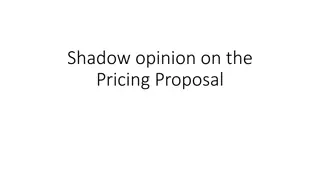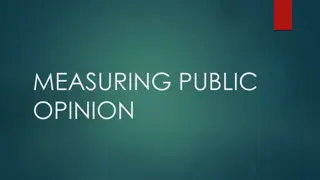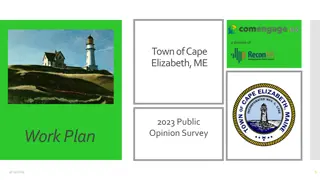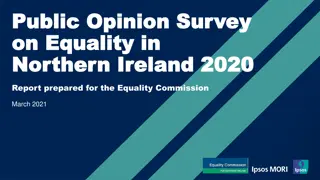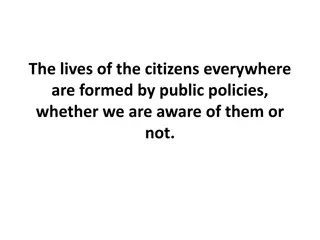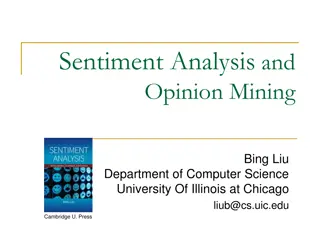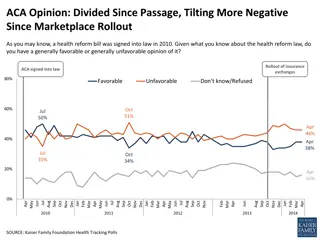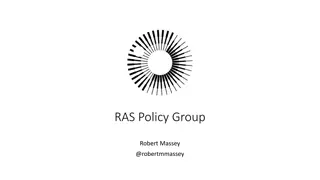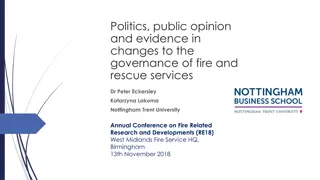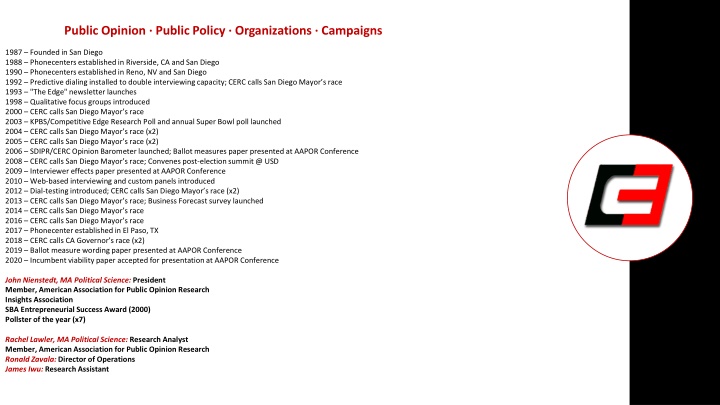
Public Opinion & Public Policy Organizations Overview
Founded in 1987 in San Diego, this organization has established phone centers in various locations over the years and has been actively involved in conducting surveys and research on public opinion and public policy campaigns. With a strong track record of conducting interviews, surveys, and launching various publications, the organization has been at the forefront of assessing political landscapes and issues. Through the leadership of key individuals like John Nienstedt, Rachel Lawler, Ronald Zavala, and James Iwu, the organization has received recognition for its contributions to public opinion research and analysis.
Uploaded on | 3 Views
Download Presentation

Please find below an Image/Link to download the presentation.
The content on the website is provided AS IS for your information and personal use only. It may not be sold, licensed, or shared on other websites without obtaining consent from the author. If you encounter any issues during the download, it is possible that the publisher has removed the file from their server.
You are allowed to download the files provided on this website for personal or commercial use, subject to the condition that they are used lawfully. All files are the property of their respective owners.
The content on the website is provided AS IS for your information and personal use only. It may not be sold, licensed, or shared on other websites without obtaining consent from the author.
E N D
Presentation Transcript
Public Opinion Public Policy Organizations Campaigns 1987 Founded in San Diego 1988 Phonecenters established in Riverside, CA and San Diego 1990 Phonecenters established in Reno, NV and San Diego 1992 Predictive dialing installed to double interviewing capacity; CERC calls San Diego Mayor s race 1993 "The Edge" newsletter launches 1998 Qualitative focus groups introduced 2000 CERC calls San Diego Mayor s race 2003 KPBS/Competitive Edge Research Poll and annual Super Bowl poll launched 2004 CERC calls San Diego Mayor s race (x2) 2005 CERC calls San Diego Mayor s race (x2) 2006 SDIPR/CERC Opinion Barometer launched; Ballot measures paper presented at AAPOR Conference 2008 CERC calls San Diego Mayor s race; Convenes post-election summit @ USD 2009 Interviewer effects paper presented at AAPOR Conference 2010 Web-based interviewing and custom panels introduced 2012 Dial-testing introduced; CERC calls San Diego Mayor s race (x2) 2013 CERC calls San Diego Mayor s race; Business Forecast survey launched 2014 CERC calls San Diego Mayor s race 2016 CERC calls San Diego Mayor s race 2017 Phonecenter established in El Paso, TX 2018 CERC calls CA Governor s race (x2) 2019 Ballot measure wording paper presented at AAPOR Conference 2020 Incumbent viability paper accepted for presentation at AAPOR Conference John Nienstedt, MA Political Science: President Member, American Association for Public Opinion Research Insights Association SBA Entrepreneurial Success Award (2000) Pollster of the year (x7) Rachel Lawler, MA Political Science: Research Analyst Member, American Association for Public Opinion Research Ronald Zavala: Director of Operations James Iwu: Research Assistant
San Diego San Diego County Issues County Issues Barometer Barometer Nov. 2022 Nov. 2022 Residents Wary of Northern Baja, as Security Concerns are Up and Visitation is Down San Diego-Tijuana not Considered a Mega Region, But Funding Sewage Treatment is Lauded
Summary Research Objective: Sample Size: Margin of Sampling Error: Confidence Level: Explore crossborder issues n=504 4.4% 95% Sample Methodology: Simple random sampling from listed sample Jurisdiction: San Diego County Eligibility: Adult residents Interview Methods: Telephone (including cell phones), e-mail push-to-web, text push-to-web Field Dates: September 2-10, 2022 Field Facility: Competitive Edge Research, El Paso TX Project Director: John Nienstedt, Sr. Research Analyst: Rachel Lawler Research Assistant: James Iwu Page | 3
Background Page | 4
San Ysidro is 1 of the Worlds Busiest Border Crossings Before the pandemic, more than 100,000 people crossed the San Diego-Tijuana border every day Boosters have heralded our area a mega-region However, safety concerns seem endemic Sewage from Tijuana entering the Pacific Ocean is another challenge An American proposal to treat the water in Mexico is being considered. Page | 5
Tijuana and Northern Baja Visitation Page | 6
71% Havent Visited Tijuana or Northern Baja in the Past Year COVID-19 shut down nonessential crossings for 20 months, with the border only reopening in November 2021 29% have made at least one trip south of the border Most visitors are Hispanic Among non-Hispanics, north coastal residents in cities like Carlsbad or Oceanside are more likely to visit County residents average 2 visits per year Rises to 8.4 crossings if the resident lives in the south suburbs. Page | 7
A Closer Look at Our Ethnic Communities Slightly more than half of Latinos visited northern Baja during the past 12 months Visitation is much more frequent Hispanics who consider themselves not to be multi-racial (generally White Hispanics) visited more regularly than Hispanics who consider themselves to be multi-racial Among Hispanics, lower levels of Hispanicity lead to more cross-border travel Slightly fewer African Americans visited Asian residents are half as likely as the wider population to visit None in our sample visited > 5 times. White Latino Black Asian All 0 70% 48% 81% 85% 72% Tijuana and Northern Baja visitations in past year 1 3% 2% 3% 8% 4% 2 10% 16% 3% 3% 8% 3-5 9% 16% 6% 4% 9% 6-10 4% 8% 5% 0% 4% 11+ 4% 10% 2% 0% 4% Page | 8
Reasons for Visiting Page | 9
Nearly 4-in-10 Cross for Vacation/Sightseeing Extremely popular for visitors outside the south suburbs Only 14% of south suburbanites visit for fun Vacationers infrequently repeat, averaging only 3.4 visits totaling 1.2 million 26% of visitors cross to visit relatives and friends 60% between SR-54 and SR-94 and 41% south of SR-54 visit loved ones Only 4% of Baja visitors living north of SR-94 visit friends and family Having relatives and friends across the border leads to 10.5 visits/year 13% go to access healthcare, medicine, or treatment More common among women in their late-20s through early-40s Visitors > 62 also head to Tijuana for medical reasons Healthcare travelers are the most frequent, averaging 11.3 visits/year 9% mainly go for nightlife/dinner Increases to 15% for non-Hispanics Nightlife seekers only make 4.7 trips per year Just 4% visited for the shopping But shoppers are frequent repeat customers, averaging 12.8 visits/year. 3.4/1.2m 10.5/2.7m 11.3/1.5m 4.7/0.4m 12.8/0.5m Page | 10
A Closer Look at Our Ethnic Communities Latinos visit friends and family in Tijuana/Baja much more often. Page | 11
Reasons for Not Visiting Page | 12
Safety Concerns Easily Top the List 44% cite this, dwarfing all other rationales Safety concerns increase with age and are politically tinged Republican non-visitors > 51 are the most worried about their safety Even half of non-Republicans 52+ express safety concerns Security fears are less of a barrier for younger residents, with only 14% < 29 avoiding for safety reasons 16% haven t visited because they have no interest or desire to go 30% of non-Whites say it s the main reason COVID protocols (8%), no friends/family (7%), and wait times (7%) are other significant barriers. Page | 13
A Closer Look at Our Ethnic Communities White Latino Black Asian All The Black community sees long border wait times as a reason for not visiting more than other ethnic groups AAPI residents more frequently have no interest or desire to visit Latinos very rarely to point to not having friends or family in the region. Safety concerns No interest/reason/desire to go No passport/Don't travel COVID protocols No family, friends in the region Long border wait times No time to go Don t speak the language Unaware of things to do in the region No one to travel with Other Unsure 48% 38% 38% 42% 44% 8% 19% 12% 25% 16% 11% 9% 10% 10% 1% 8% 3% 13% 8% 8% Reasons for Not Visiting Tijuana and Northern Baja 8% 1% 1% 8% 7% 7% 1% 2% 7% 7% 0% 20% 7% 0% 2% 1% 3% 7% 2% 2% 1% 0% 0% 0% 1% 0% 1% 4% 40% 0% 4% 4% 3% 4% 0% 2% 0% 1% 1% 3% Page | 14
Impressions of Northern Baja Page | 15
A Large Minority Draw a Blank Despite being geographical neighbors, 45% have no impression or a neutral impression of northern Baja And the region has as many fans (26%) as critics (28%) Views largely come down to the safety issue and visitation Those who don t visit specifically because they re concerned about safety savage the area Most non-visitors don t know the area One-timers are negative But multiple visits improve opinions. Page | 16
A Closer Look at Our Ethnic Communities Most Blacks have no impression of northern Baja Most AAPI residents have no impression What impression there are are negative None in our sample voiced very positive views of the region Latinos frequently hold more positive views overall and are twice as likely to have a very positive opinion Despite visiting less frequently, Hispanics who consider themselves multi-racial like the area more often than White Hispanics. White Latino Black Asian All No Impression 34% 37% 69% 62% 40% Very negative 14% 10% 1% 12% 13% Impression of Northern Baja California Somewhat negative 17% 10% 8% 18% 15% Neutral/Unsure 6% 4% 4% 2% 5% Somewhat positive 18% 18% 10% 5% 17% Very positive 11% 20% 7% 0% 9% Page | 17
Are San Diego and Tijuana a Mega-Region? Page | 18
No, The Cities are Separate Business boosters continue to pitch the two metropolises as a mega-region However, most San Diego residents definitely view the two as distinct cities San Diego is hugely influenced by Latino culture, but residents generally view the two cities as independent each other. Upbeat residents are less likely to discount the "mega-region" concept But even most of them aren t buying it Republicans are largely united in their belief that the two border cities are separate Nonpartisans, minor party voters, non- registrants generally agree However, > one-third of Democrats believe the cities constitute a mega-region. Page | 19
A Closer Look at Our Ethnic Communities The three communities don t see San Diego and Tijuana as a mega-region However, 43% of multi-racial Hispanics do see it that way On the other hand, fewer White Hispanics agree with the mega-region concept. Page | 20
Funding Wastewater Treatment Facilities Page | 21
Most Support Funding Sewage Treatment in Mexico San Diegans reject the mega-region concept but 72% want the US to pay for treatment plants located across the border OPINION OF PAYING FOR WASTEWATER TREATMENT FACILITIES IN MEXICO OPPOSE, STRONGLY OPPOSE, SOMEWHAT UNSURE/NEUTRAL/DEPENDS FAVOR, SOMEWHAT FAVOR, STRONGLY 11% 9% 9% 27% 45% Opinions are unrelated to feelings about northern Baja or even how often someone visits the area This is more about tapping San Diegan s pride in their beaches, which are a major tourism driver Residents who feel good about the county's direction are very gung-ho about the project But the widespread support from less positive residents cements this as a popular endeavor Unhappy residents are much less in favor, but even most them are supportive Support will soften but not evaporate -- if things turn sour, as in a recession. Page | 22
A Closer Look at Our Ethnic Communities There are no differences when it comes to whether to fund the water treatment project. Page | 23
Thank You! Page | 24
Public Opinion Public Policy Organizations Campaigns 1987 Founded in San Diego 1988 Phonecenters established in Riverside, CA and San Diego 1990 Phonecenters established in Reno, NV and San Diego 1992 Predictive dialing installed to double interviewing capacity; CERC calls San Diego Mayor s race 1993 "The Edge" newsletter launches 1998 Qualitative focus groups introduced 2000 CERC calls San Diego Mayor s race 2003 KPBS/Competitive Edge Research Poll and annual Super Bowl poll launched 2004 CERC calls San Diego Mayor s race (x2) 2005 CERC calls San Diego Mayor s race (x2) 2006 SDIPR/CERC Opinion Barometer launched; Ballot measures paper presented at AAPOR Conference 2008 CERC calls San Diego Mayor s race; Convenes post-election summit @ USD 2009 Interviewer effects paper presented at AAPOR Conference 2010 Web-based interviewing and custom panels introduced 2012 Dial-testing introduced; CERC calls San Diego Mayor s race (x2) 2013 CERC calls San Diego Mayor s race; Business Forecast survey launched 2014 CERC calls San Diego Mayor s race 2016 CERC calls San Diego Mayor s race 2017 Phonecenter established in El Paso, TX 2018 CERC calls CA Governor s race (x2) 2019 Ballot measure wording paper presented at AAPOR Conference 2020 Incumbent viability paper accepted for presentation at AAPOR Conference John Nienstedt, MA Political Science: President Member, American Association for Public Opinion Research Insights Association SBA Entrepreneurial Success Award (2000) Pollster of the year (x7) Rachel Lawler, MA Political Science: Research Analyst Member, American Association for Public Opinion Research Ronald Zavala: Director of Operations James Iwu: Research Assistant

